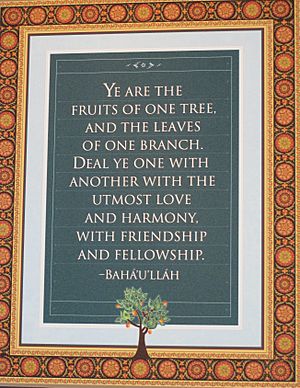Ye (pronoun) facts for kids

Ye is a pronoun, which is a word that takes the place of a noun. It means "you" when talking to more than one person. Think of it like saying "y'all" or "you guys" today. In Old English, it was spelled "ge".
Long ago, in Middle English and Early Modern English, "ye" was used in two main ways. It could be used informally when talking to a group of friends or equals. It was also used formally, as a polite way to address a group of people or someone important.
Today, "ye" is not used much in most English-speaking places. It sounds very old-fashioned. However, you might still hear it in Newfoundland and Labrador in Canada. Some parts of Ireland also use it. In these places, "ye" helps people know if you are talking to one person ("you") or many people ("ye").
"Ye" and "The"
Sometimes, people get "ye" mixed up with the word "the." This happens because of how "the" was written a long time ago.
In Early Modern English, "the" was often written as "
" The letter that looks like a "y" in this old writing is actually a special letter called thorn. Thorn looked a bit like a "y" in some old handwriting. So, the word "The" was written as "Þe" (with thorn) and never "Ye."
When printing presses first came along, they didn't have the thorn letter. So, printers often used the letter "y" instead because it looked similar. This is why you might see old signs that say "Ye Olde Shoppe."
Because of this, many people today see "ye" in old texts and think it should be pronounced "yee." But when it's used instead of "the," it should actually be pronounced "thee" or "thuh."
Where Did "Ye" Come From?
In Old English, there were clear rules for pronouns:
- þū was used for one person.
- ġit was used for two people.
- ġē was used for more than two people.
After the Norman Conquest (when French speakers took over England), the French language started to influence English. French had a rule where you used a plural pronoun (like "vous") to be polite to someone important, even if you were talking to just one person. This was also done for kings and other important people.
This idea, called the T–V distinction, slowly changed how English speakers used "you" and "ye." The singular "thou" (which came from "þū") started to be replaced by the plural "ye" (which came from "ġē") when talking to someone important or even just someone you didn't know well. Using the plural was seen as more polite.
In Early Modern English, "ye" became both an informal way to talk to a group and a formal way to talk to one important person.
Today, "ye" is still used as an informal plural in places like Hiberno‐English (Irish English) and Newfoundland English. These dialects also use other forms of "ye," like "yeer" (meaning "your"), "yeers" (meaning "yours"), and "yeerselves" (meaning "yourselves").
| Nominative | IPA | Accusative | Dative | Genitive | |||
|---|---|---|---|---|---|---|---|
| 1st | Singular | iċ | [itʃ] | mec / mē | mē | mīn | |
| Dual | wit | [wit] | uncit | unc | uncer | ||
| Plural | wē | [weː] | ūsic | ūs | ūser / ūre | ||
| 2nd | Singular | þū | [θuː] | þec / þē | þē | þīn | |
| Dual | ġit | [jit] | incit | inc | incer | ||
| Plural | ġē | [jeː] | ēowic | ēow | ēower | ||
| 3rd | Singular | Masculine | hē | [heː] | hine | him | his |
| Neuter | hit | [hit] | hit | him | his | ||
| Feminine | hēo | [heːo] | hīe | hiere | hiere | ||
| Plural | hīe | [hiːy] | hīe | heom | heora | ||
| Person / gender | Subject | Object | Possessive determiner | Possessive pronoun | Reflexive | |
|---|---|---|---|---|---|---|
| Singular | ||||||
| First | ic / ich / I I |
me / mi me |
min / minen [pl.] my |
min / mire / minre mine |
min one / mi selven myself |
|
| Second | þou / þu / tu / þeou you (thou) |
þe you (thee) |
þi / ti your (thy) |
þin / þyn yours (thine) |
þeself / þi selven yourself (thyself) |
|
| Third | Masculine | he he |
him / hine him |
his / hisse / hes his |
his / hisse his |
him-seluen himself |
| Feminine | sche[o] / s[c]ho / ȝho she |
heo / his / hie / hies / hire her |
hio / heo / hire / heore her |
- hers |
heo-seolf herself |
|
| Neuter | hit it |
hit / him it |
his its |
his its |
hit sulue itself |
|
| Plural | ||||||
| First | we we |
us / ous us |
ure[n] / our[e] / ures / urne our |
oures ours |
us self / ous silve ourselves |
|
| Second | ȝe / ye you (ye) |
eow / [ȝ]ou / ȝow / gu / you you |
eower / [ȝ]ower / gur / [e]our your |
youres yours |
Ȝou self / ou selve yourselves |
|
| Third | From Old English | heo / he | his / heo[m] | heore / her | - | - |
| From Old Norse | þa / þei / þeo / þo | þem / þo | þeir | - | þam-selue | |
| modern | they | them | their | theirs | themselves | |
Many other variations are noted in Middle English sources due to difference in spellings and pronunciations. See Francis Henry Stratmann (1891). A Middle-English dictionary. [London]: Oxford University Press. http://openlibrary.org/books/OL7114246M/A_Middle_English_dictionary. and A Concise Dictionary of Middle English from A.D. 1150 TO 1580, A. L. Mayhew, Walter W. Skeat, Oxford, Clarendon Press, 1888.
| Nominative | Oblique | Genitive | Possessive | ||
|---|---|---|---|---|---|
| 1st person | singular | I | me | my/mine | mine |
| plural | we | us | our | ours | |
| 2nd person | singular informal | thou | thee | thy/thine | thine |
| singular formal | ye, you | you | your | yours | |
| plural | |||||
| 3rd person | singular | he/she/it | him/her/it | his/her/his (it) | his/hers/his |
| plural | they | them | their | theirs | |
See also
- Y'all
- Yinz


